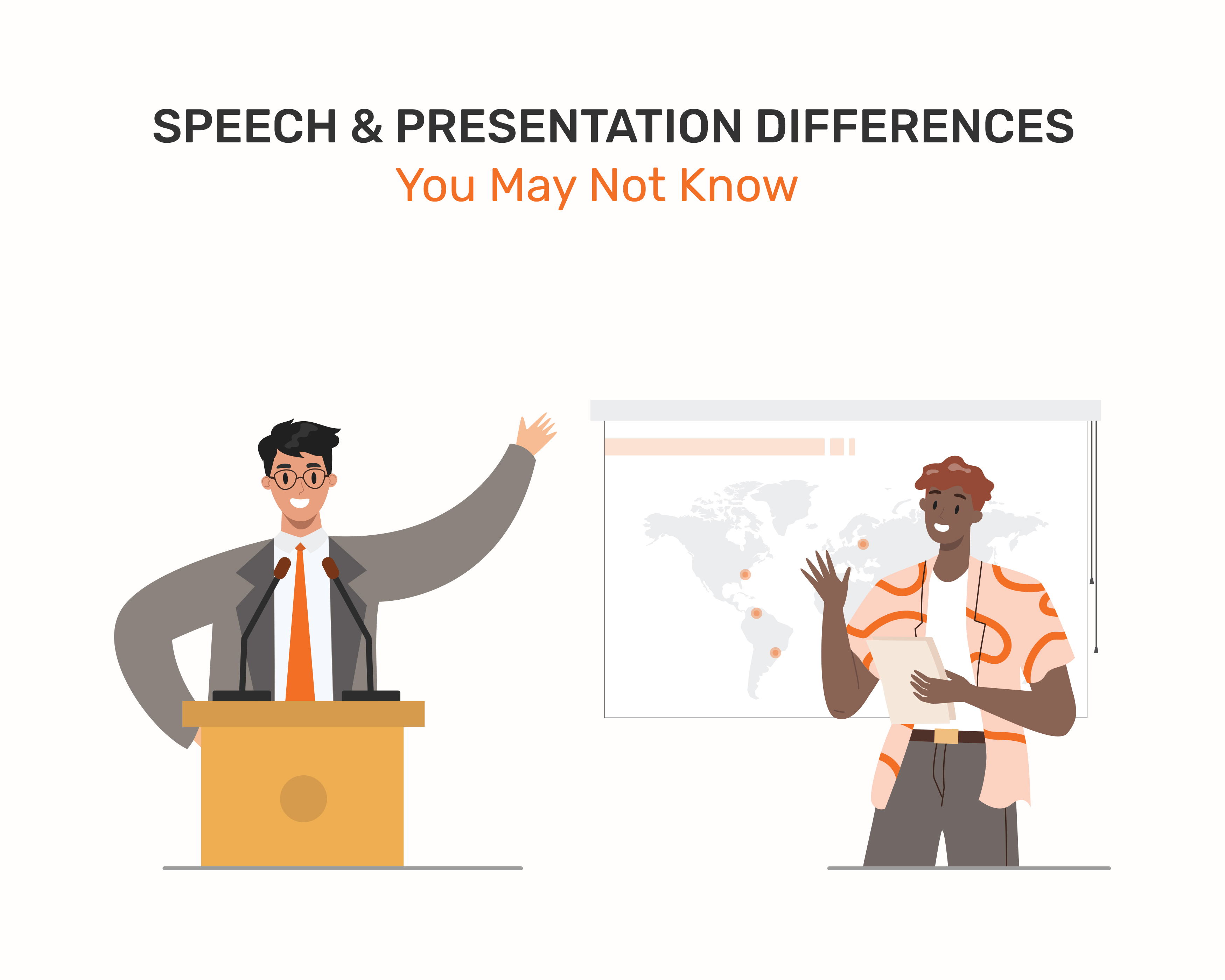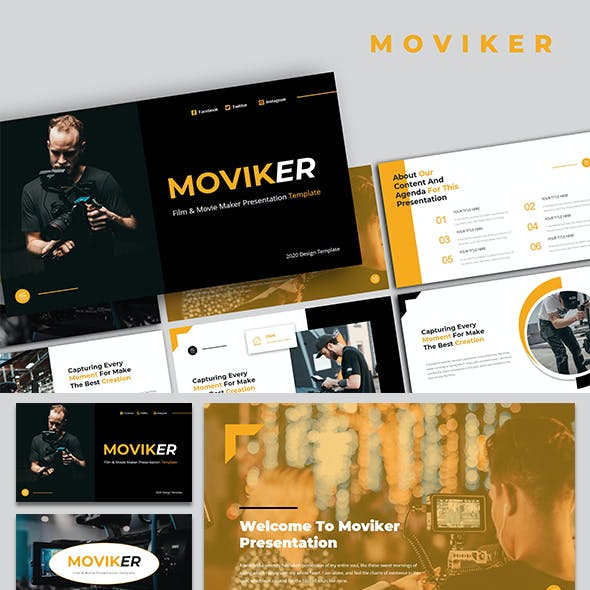Speech Vs Presentation: Get The Main Difference?
In the world of communication, there are different ways we express ourselves: through speeches and presentations. But wait, what’s the difference between a speech and a presentation? Let’s break it down!
Imagine you’re standing in front of an audience, sharing your thoughts and ideas. That’s a speech! It’s like having a conversation with a large group of people, where you have the stage all to yourself.
On the other hand, a presentation is like a visual aid that accompanies your speech. It can include slides, videos, and other multimedia elements that help to enhance your message and make it more engaging. So, while a speech relies mainly on your words, a presentation adds that extra visual element.
Now that we know the basics, let’s dive deeper into the world of speeches and presentations and uncover their unique features and purposes. Get ready to conquer the stage and captivate any audience with your powerful words and eye-catching visuals!
Looking to communicate effectively? While both speech and presentation are forms of conveying information, they differ in style and purpose.
- Speech: Typically delivered orally with a focus on storytelling and engaging the audience.
- Presentation: Visual aids such as slideshows accompany the speaker’s message to enhance understanding.
- Speech emphasizes the spoken word, while presentations provide a visual component.
- Speeches often involve more improvisation, while presentations are carefully planned and structured.
- Ultimately, the choice between speech and presentation depends on the context and desired impact on the audience.

Principales puntos clave
1. Una presentación es cuando muestras visualmente información mientras hablas, mientras que un discurso se enfoca principalmente en transmitir información verbalmente.
2. Las presentaciones pueden incluir diapositivas, gráficos o videos, mientras que los discursos se basan principalmente en el habla.
3. En una presentación, el objetivo es captar la atención del público de manera visual, mientras que en un discurso, el objetivo es transmitir el mensaje de manera clara y persuasiva.
4. En una presentación, las habilidades de diseño gráfico y el uso efectivo de multimedia son importantes, mientras que en un discurso, las habilidades de oratoria y la organización del contenido son fundamentales.
5. Tanto las presentaciones como los discursos requieren práctica y preparación, pero el enfoque principal de cada uno es diferente: visual para las presentaciones y verbal para los discursos.
Comparing Speech vs. Presentation
Comparing Speech vs. Presentation
Speech and presentation are two different methods of communication that serve distinct purposes and have their own unique characteristics. While both involve conveying information to an audience, they differ in terms of format, delivery, and overall objectives. In this article, we will compare speech and presentation, exploring their key features, user experience, pros and cons, price points, and ultimately determine which is better suited for different situations.
Overview of Speech
Speech, in its simplest form, is the act of delivering a spoken message to an audience. It is typically performed by a speaker using their voice, body language, and gestures to convey their ideas and connect with the listeners. Whether it’s a formal address, an inspirational talk, or a persuasive argument, speeches are designed to engage, inform, entertain, and influence.
In a speech, the focus is primarily on the speaker’s delivery and their ability to captivate the audience. The content of the speech is often carefully crafted, incorporating rhetorical devices, storytelling techniques, and persuasive elements to create an impactful message. Public speaking skills, such as voice modulation, articulation, and stage presence, are essential for delivering a compelling speech.
Overview of Presentation
A presentation, on the other hand, is a visual and auditory communication tool used to convey information in a structured and visually appealing format. It typically involves the use of slides, graphics, videos, and other multimedia elements to support the speaker’s message. Presentations can be created using software like Microsoft PowerPoint or Apple Keynote, allowing the presenter to showcase data, visuals, and key points in a streamlined manner.
The emphasis in a presentation lies not only on the speaker’s delivery but also on the visual aids and supporting materials used. Presentations often follow a clear structure, with an introduction, main body, and conclusion, allowing the audience to easily follow the flow of information. The visual elements in a presentation can enhance understanding, clarify complex topics, and make the content more engaging for the audience.
Key Features Compared
Speech and presentation have distinct features that set them apart in terms of their format, delivery, and overall impact. Let’s explore these key features and compare the two:
Format
Speech: A speech is primarily an oral presentation delivered by a speaker, relying on their voice, body language, and facial expressions to convey the message. The content of a speech is usually written down and rehearsed, but the delivery can be more spontaneous and interactive.
Presentation: A presentation is a visual and auditory communication tool that incorporates slides, visuals, and multimedia elements to support the speaker’s message. The content of a presentation is organized into a structured format, often using software programs, and relies on both the speaker’s delivery and the visual aids.
Delivery
Speech: The delivery of a speech is focused on the speaker’s voice, tone, and overall stage presence. The speaker’s ability to connect with the audience through their delivery plays a crucial role in the impact of the speech. However, there is often less emphasis on the visual aspects of the presentation.
Presentation: In a presentation, the delivery encompasses both the speaker’s verbal communication and their ability to effectively utilize visual aids and technology. The presenter must synchronize their speech with the slides, ensuring a cohesive and engaging delivery that incorporates the visual elements.
Objectives
Speech: The primary objective of a speech is often to inform, persuade, or inspire the audience. Whether it’s a motivational speech, an educational lecture, or a persuasive argument, the goal is to captivate the listeners and convey a compelling message.
Presentation: Presentations are commonly used for informative purposes, such as sharing research findings, giving product demonstrations, or delivering business proposals. The objective is to present information in a visually appealing and organized manner that enhances audience understanding.
Visual Elements
Presentations typically include various visual elements that enhance the delivery and understanding of information. These elements can include:
– Slides: Slides are the backbone of a presentation, containing text, images, charts, graphs, and other visual representations of information. They provide a structure and guide the presenter and audience through the content.
– Multimedia: Presentations often incorporate multimedia elements, such as videos and audio clips, to add variety and enhance engagement. These elements can help illustrate concepts, provide real-life examples, or showcase product demonstrations.
– Animations: Animations and transitions can be used to add visual interest and create seamless transitions between slides or elements within a slide. When used effectively, they can enhance the overall flow and engagement of the presentation.
– Graphics and Icons: Visual elements like icons, illustrations, and infographics can simplify complex information, making it more accessible and visually appealing to the audience.
Interactivity
Speech: Speeches can often involve a level of interactivity with the audience, depending on the style and purpose of the speech. This can include engaging in a question-and-answer session, encouraging audience participation, or incorporating interactive activities.
Presentation: Interactivity in presentations can vary depending on the delivery method and audience. In some cases, presentations may include interactive elements, such as polls, quizzes, or audience participation through live feedback systems. However, presentations are generally more structured and less interactive compared to speeches.
User Experience
Speech: The user experience of a speech largely depends on the speaker’s ability to deliver a captivating message and engage the audience. A successful speech should leave the audience feeling inspired, informed, or moved by the speaker’s words.
Presentation: The user experience of a presentation is influenced by the visual appeal, organization, and clarity of the content. Well-crafted presentations that effectively convey information and engage the audience can leave a positive impression and enhance the overall user experience.
Pros and Cons
Speech
Pros:
– Powerful delivery: A well-delivered speech has the potential to captivate and move the audience through the speaker’s voice, gestures, and stage presence.
– Personal connection: A speech allows the speaker to establish a personal connection with the audience, as they can see and hear the speaker in real-time.
– Flexibility: Speeches can be tailored to different audiences and occasions, allowing for adaptability and customization.
Cons:
– Limited visual aids: Speeches rely primarily on the speaker’s delivery and the power of their words, which may limit the use of visuals and multimedia elements.
– Less structured format: Speeches can be more spontaneous and less rigid in terms of structure, which can sometimes lead to less clarity or organization in the content.
– Lack of visual appeal: As speeches focus on the spoken word, they may not offer the same level of visual appeal or engagement as presentations.
Presentation
Pros:
– Visual impact: Presentations leverage visual elements to enhance the delivery of information, making it more engaging and memorable for the audience.
– Clarity and organization: Presentations often follow a structured format, making it easier for the audience to follow the flow of information and understand complex concepts.
– Multimedia integration: Presentations allow for the seamless integration of multimedia elements, such as videos, charts, and images, which can enhance audience understanding.
Cons:
– Dependency on technology: Presentations rely heavily on technology and visual aids, which can be subject to technical glitches or equipment failures.
– Potential for information overload: If a presentation is poorly designed or overloaded with information, it can overwhelm the audience and make the content difficult to absorb.
– Less personal connection: Compared to speeches, presentations may have a less personal and intimate connection with the audience, as they primarily focus on the visual and auditory aspects of communication.
Price Comparison
When it comes to the cost of implementing speech and presentations, several factors come into play. Here are some considerations for price comparison:
– Software: The cost of presentation software can vary depending on the provider and the specific features included in the package. Popular presentation software options include Microsoft PowerPoint, Apple Keynote, and Google Slides.
– Equipment: To deliver a presentation or speech effectively, certain equipment may be required, such as a laptop, projector, microphone, and speakers. The cost of these equipment items can range depending on the brand, quality, and features.
– Professional services: If you require assistance with presentation creation, design, or speechwriting, you may need to consider the cost of hiring professionals or consultants who specialize in these areas.
It’s important to note that the cost comparison will vary depending on individual needs, preferences, and the scale of the presentation or speech. It’s advisable to research and consider different options to determine the most cost-effective solution for your specific requirements.
Comparison Table
| Feature | Speech | Presentation |
|——————–|—————————–|————————|
| Visual Elements | Limited visuals | Multimedia integration |
| Delivery | Focus on speaker | Speaker and visuals |
| Interactivity | Potential for Q&A | Level of interactivity |
| User Experience | Impactful delivery | Visual appeal |
| Pros and Cons | Pros and cons of speech | Pros and cons of presentation |
| Price Points | Cost considerations for speech | Cost considerations for presentation |
Which is Better – Speech or Presentation?
When deciding whether a speech or presentation is better suited for a particular situation, several factors need to be considered, including the objectives, audience, and context. Here are three reasons why one might be preferred over the other:
1. Information delivery: If the primary goal is to convey a message in a highly personalized and engaging manner, a speech may be the better choice. A well-delivered speech can establish a strong emotional connection with the audience and leave a lasting impact.
2. Visual impact: If the content to be presented relies on visual aids, such as data, graphics, or multimedia elements, a presentation would be more suitable. Presentations allow for the seamless integration of visuals, enhancing the audience’s understanding and engagement with the information.
3. Structure and organization: If the content needs to be presented in a clear and organized manner, with a predefined structure and flow, a presentation is the better option. The structured format of a presentation ensures that information is presented in a logical and digestible manner, making it easier for the audience to follow and comprehend.
Ultimately, the choice between a speech and a presentation depends on the specific objectives, audience, and context of the communication. Both methods have their strengths and can be highly effective when used appropriately. It is essential to consider the key features, pros, and cons of each to determine the best approach for your specific needs.
Frequently Asked Questions
Are you confused about the differences between a speech and a presentation? Don’t worry, we’ve got you covered! Check out these commonly asked questions to gain a better understanding of speech versus presentation.
1. What is the main difference between a speech and a presentation?
A speech and a presentation are both forms of communication, but they differ in their intent and delivery style. A speech is typically a verbal address given by one person, often without visual aids, and is more focused on delivering a message or conveying emotions. On the other hand, a presentation combines speech with visual aids, such as slides or graphics, and is more concerned with sharing information or persuading an audience.
Think of a speech as a heartfelt talk meant to inspire or motivate, while a presentation is a more structured and informative way to convey facts or ideas.
2. When should I use a speech and when should I use a presentation?
The choice between using a speech or a presentation depends on your purpose and audience. Use a speech when you want to connect on a deeper emotional level, such as during a graduation ceremony or a motivational event. The lack of visual aids allows for a stronger emphasis on your words and delivery style.
On the other hand, use a presentation when you need to present information in a clear and organized manner. This is useful in educational settings, business meetings, or conferences where you want to enhance audience understanding using visual aids and slides. Additionally, a presentation can be helpful when you need to convince or persuade others by illustrating key points with supporting visuals.
3. How should I prepare for a speech?
To prepare for a speech, start by identifying your main message and purpose. Think about the emotions you want to convey and the impact you want to make on your audience. Craft a clear and concise outline, organizing your speech into an introduction, body, and conclusion.
Practice delivering your speech aloud, paying attention to your tone, pacing, and body language. Use personal stories or anecdotes to engage and connect with your audience. It can also be helpful to rehearse in front of a mirror or record yourself to identify areas for improvement and build confidence in your delivery.
4. How should I prepare for a presentation?
To prepare for a presentation, start by clarifying your main objective and identifying the key points you want to convey. Create visually appealing slides that support your message, using clear and concise text, relevant images, and graphs or charts if necessary.
Practice your presentation multiple times to ensure a smooth and confident delivery. Pay attention to your tone of voice, body language, and eye contact with the audience. Familiarize yourself with the technology or equipment you will be using, such as a projector or microphone, to avoid any technical difficulties during your presentation.
5. How can I engage my audience during a speech or presentation?
To engage your audience during a speech or presentation, consider using storytelling techniques to make your content relatable and memorable. Incorporate interactive elements, such as asking questions or encouraging audience participation, to create a sense of involvement.
Additionally, maintain eye contact with your audience, vary your vocal tone and gestures to keep their attention, and use visual aids effectively to support your message. Encouraging questions or discussion after your speech or presentation also allows for further engagement and interaction with your audience.

Differences between a speech and a presentation (With examples)
Summary
In a nutshell, speeches and presentations both involve talking to an audience, but there are some key differences between them. A speech is typically longer and more formal, like the kind you might give at a special event or ceremony. Presentations, on the other hand, are shorter and often involve visual aids like slides or props. They are usually given in a business or educational setting.
When giving a speech, it’s important to use clear and concise language, as well as to connect with the audience on an emotional level. This helps to capture their attention and make your message memorable. In contrast, presentations rely on visual elements to support the information being shared. This can include graphs, pictures, or even videos. These visual aids help to make complex ideas easier to understand.
Remember, whether you’re giving a speech or a presentation, practice is key. The more you rehearse, the more confident and comfortable you’ll feel in front of an audience. Don’t forget to maintain eye contact, speak clearly, and engage with your listeners. By following these tips, you’ll be well on your way to becoming a confident and effective speaker or presenter.



